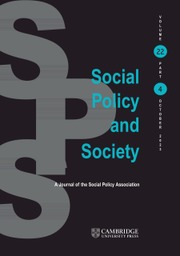No CrossRef data available.
Article contents
Why Do Families of Children with Disabilities Discontinue Using Rehabilitation Services? A Qualitative Study in Rural Mainland China
Published online by Cambridge University Press: 28 November 2024
Abstract
Rehabilitation services play a vital role in the quality of life for children with disabilities. China has established a system of rehabilitation services, in which eligible children with disabilities are entitled to free rehabilitation services at designated institutions. This study reveals, however, that some rural families decide to discontinue the free rehabilitation services. This study attempts to explore the reasons for their decision through qualitative methods. We find that the ideology of developmentalism with its emphasis on efficiency dominates policy actors’ thinking and actions. In a cultural discourse that prioritises utility and economic development, children with disabilities are regarded by policy implementers as a ‘non-priority’, by their service providers as an opportunity for profit, and by their parents as ‘futureless’. That these families discontinue using these free services seems to result from the policy attitudes mentioned above.
Keywords
- Type
- Article
- Information
- Copyright
- © The Author(s), 2024. Published by Cambridge University Press


